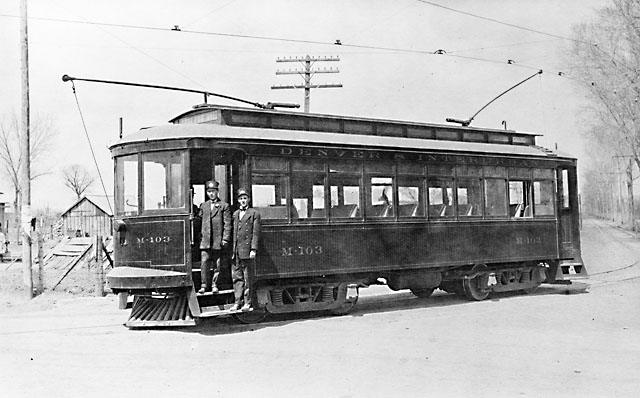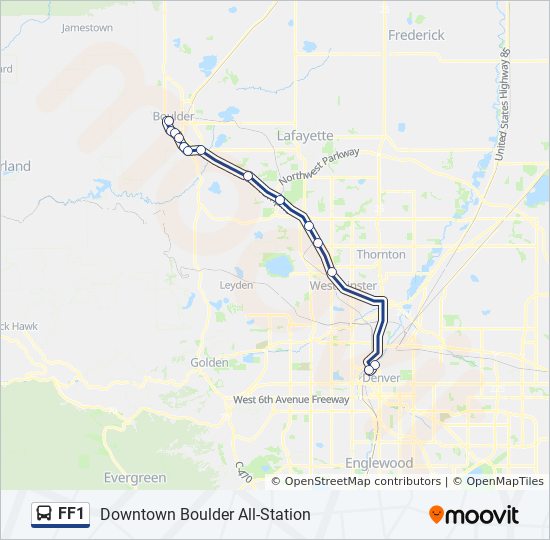-----
 |
| Colorado and Southern mogul No. 22, photographed by Otto Perry in 1918 (Denver Library) |
The Colorado & Southern (C&S) first organized the Denver & Interurban (D&I) in 1904 with plans to connect Denver to Boulder and, eventually, onto Fort Collins. Despite the northward direction of the name, C&S worked top-down and started instead in Fort Collins by establishing a city streetcar line. Construction began on July 9, 1907, when contemporary reports by the Fort Collins Express reported a "steam traction engine" ploughing up West Mountain Avenue. As Fort Collins was a small town, it took only nine miles built over 5 months to make a substantial transit line. The new D&I railway would open on December 29, 1907, just in time to ring in the New Year. (I would go on here, but Fort Collins is worthy for an episode to itself.)
 |
| Official photograph of D&I Fort Collins car M-103 with crew, 1909 (Fort Collins Images) |
As the D&I was setting up its streetcar line, its interurban fortunes were being arranged as well with a substantial 51-mile loop line: starting from the Denver Tramway and Intermountain loop at 15th and Arapahoe, trains would run northeast to Globeville before cutting Northwest to Standley Lake in Westminster; it would then continue past Church's, Broomfield, and Burns Junction, before splitting at Louisville Junction. From here, a train could either go to Superior in the west or Louisville in the east, with the Louisville line offering spur-line service to the resort community of Eldorado Springs (famous for its "Radium Pool" and bottled water brand.) Both lines would then converge on Boulder, forming a complete loop that, on a map, better resembled a kite with Eldorado Springs as the string. This earned the D&I its "Kite Route" moniker in advertising and public conscious.
 |
| The Kite Route's iconic shape from a company pamphlet (Worthpoint) |
 |
| A D&I car sitting in Denver, year unknown but given the horse and buggy, probably before 1910. (Museum of Boulder) |
The Kite Route would open on June 23, 1908 with the first train leaving Denver at 3PM. Onboard was Colorado Governor Henry Buchtel, Denver mayor Robert Speer, and Boulder mayor Isaac Earl, along with members of the press who would later declare, "Boulder is now a suburb of Denver." Denver & Interurban also promised two-hour intervals between every train on the system, even to Eldorado Springs, and seemed to have lived up to that as contemporary reports sang praises of the line's consistent scheduling and the clean service. The cars and trailers utilized a unique 11K-volt AC system and were built and furnished by the Niles Car Company of Niles, Ohio, using a combination of steam and electric railroad stylings that could effectively sit 64 people in attention-grabbing comfort.
 |
| An artistic depiction of Denver & Interurban Motor M-151 and trailer 201,showing a blatant disregard for trucks in relation to perspective. (Worthpoint) |
 |
| D&I M-153 looking very pleased with itself after running over someone's Ford motorcar. The lack of a plow post-strike is evident. (Denver Library) |
Unfortunately the praises of the railroad end there, as Colorado & Southern was bought out by the larger Chicago, Burlington, and Quincy (CB&Q) by the end of 1908. CB&Q had no interest in the D&S's interurban holdings and quickly halted the expansion into Fort Collins; the only additional spur built around this time reached Westminster College. The line continued to see heavy ridership, averaging at 565,000 riders made up of commuters and tourists, but fortunes turned as automobile ownership rose starting in the late 1910s. This turn in fortune culminated on Labor Day 1920, when two heavily-laden trains collided head-on in Globeville and left twelve people dead. While the company would recover financially, further crossing strike incidents and a decline in public utility led the CB&Q to end D&I operations in 1926. Its Boulder service was replaced by the Denver & Interurban Motor Company bus service.
Today, the only remnant of the original Kite Route is run as RTD bus route FF2 under the moniker, "Flatiron Flyer". Instead of going towards Louisville or Superior, the FF2 cuts through the kite's middle to connect Denver Union Station with Boulder Transit Center. No cars from the original D&I still exist, but a significant portion of the streetcars still lives on in Fort Collins, which is a story for another time.
 |
| The new Denver RTD FF2 "Flatiron Flyer" route, now a straight line to Boulder via Superior with a spur to Louisville by regional rail. (Moovit app) |
-----
Finding information for this episode was difficult seeing as the Denver & Interurban and Denver & Intermountain were just about interchangeable with each other on the internet. Nevertheless, if you want a more in-depth history of this obscure electric railway, find yourself a copy of The Kite Route; Story of the Denver & Interurban Railroad by William C. Jones and Noel T. Holley. As usual, if you want to follow myself or my editor on twitter, or just want to buy a shirt, follow the links available! Thanks for reading and ride safe until next week!

No comments:
Post a Comment